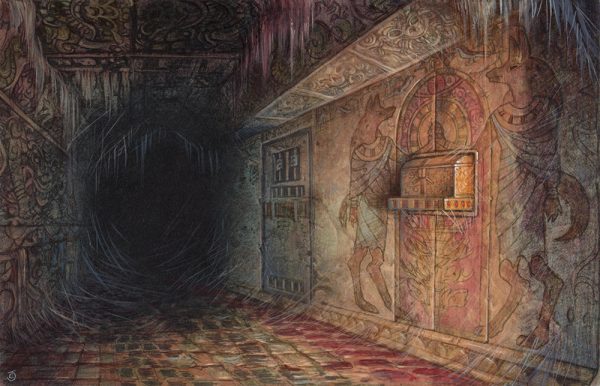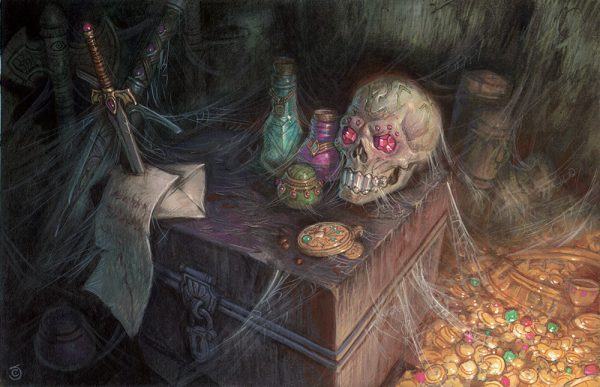
Recently I took to Twitter after finishing up my work on Star Beneath the Sands to discuss a method I use for planning out some of my adventures. I call it ‘the 4M method’. It’s the same method I used when writing the Tomb of Tiberesh and Under the Devil’s Thumb. In this approach the 4 key ideas are used, which I’ll describe below, to plan out areas and encounters. This is not a high level outline where you’d include things like like history, introductions, plot hooks and arcs, or their resolutions. Rather, this is a more granular method for brainstorming and building adventure locales meant to be explored and overcome by a party of characters. Hopefully, you’ll find the 4M method is a multipurpose one, its two biggest strengths being to outline and inspire.
It’s worth mentioning that I use this technique for dungeons, because that’s primarily what I create – locale-based exploration adventures that have a fair amount of combat, puzzles, and unique mechanics. Throughout this article I’ll use the words “dungeon” for the container we’re creating within and “chambers” or “rooms” as its individual parts but keep in mind that a “dungeon” can be anything. A shipwreck, a forest, the hollowed out corpse of a dead god, or basically any area that centers around exploration that would be divided up into sections. I’m not sure how well this method would work if you were building a mostly narrative adventure, as I’ve never tried. My assumption is that it probably wouldn’t work very well. So if you’re working on your latest Tiefling love triangle adventure set in the Plane of Eternal Melodrama, or you refer to your players as your “cast” then you’ll likely not find any of this useful. Again though, that’s just not my thing. Moving on, let’s get to what the 4 M’s are exactly.
- Motifs
- Mechanics
- Mysteries
- Monsters
They’re modified a bit to make the title a bit more memorable, or else I’d call this method the MMSC (Motifs, Mechanics, Secrets, Creatures) method, but that doesn’t quite have the same ring to it, does it? It’s important that these be filled out in this particular order, so that you can go from taking the biggest picture item and zoom down to the most granular one. Again, this method is for planning / brainstorming / getting inspired and not meant to be a hard/fast final-draft quality material. Let’s dive in!
1.) Motifs
These are the big ideas and overall aesthetic / vibe of a chamber. What’s the biggest / coolest / most striking or important feature of the room and how should it make players feel when they first hear its description. Think of this as the read aloud text, regardless of whether or not you actually use read aloud text or not in your games. Not only does the motif section cover the overall sweeping feel of what the characters step into, but it also accounts for more granular elements such as literal motifs, colors, patterns, scents, sounds, and sensations. Here’s an example from one I recently worked on:
Wavelike patterns paint the rim of the ceiling, cartouches signaling the God’s name and murals depicting ritual sacrifice, and divine reward. Ivory inlaid with gold, smooth / reflective surfaces all around. Giant golden Ram head dominates the room, below it a stout stone sarcophagus flanked by 6 criospinx. Immaculate and well sealed, still smells faintly of blue lotus perfume.

Now, does this mean all of those elements will make it into the finished product or within the read aloud text? No. This merely serves as a guidepost for you when you begin laying the groundwork of the more concrete ideas and all the other pieces are in place.
2.) Mechanics
What types of things should be going on in this chamber both literally and narratively? Scything traps, warding idols, puzzle obelisks, magic mouths speaking riddles, obstacles to traverse or avoid, impending combat, the dungeon overlord scrying on the characters or anything else they will need to face or interact with (even passively) in order to proceed. Visual storytelling also comes into play here. What do the arrangement of objects in this chamber tell the characters? Do any flavor / window dressings here actually help tell more of the story? What are characters drawn to? What other dangers can we allude to without simply placing monsters inside? Here’s a quick example:
Precarious narrow pathways are split by pendulum blades and also threaten a long fall for the careless / daring. The skeletal remains in the corner appear to be the result of a self-inflicted injury. Tomb guardians only attack if the idol is removed from its pedestal. If blasphemy is spoken within this chamber, the gods bestow a curse upon its speaker.
Again, maybe all of these things don’t make sense together, but this is a brainstorming session. Once all 4 M’s have been completed you can double back and basically “connect the dots” and find something that gels well – then you eliminate the rest. Well, you eliminate the rest or save the ones you really liked for another chamber they might make more sense in. Think of this whole process as being similar to mind-mapping, but without all the mess.
3. Mysteries
These are the secrets within the area, both within the narrative as well as mechanically. Is there a false bottom in a drawer containing the key to a previously locked door/chest perhaps? Does the ancient smith’s anvil rotate on its base to reveal a nearby secret entrance? As much as it is about these more conventional mysteries, it’s also about what characters can’t or didn’t see before they came into the room. Was a fated royal usurped in this chamber ages ago and their ghost still watches over the chamber, compelling characters in some way? Were some kobolds just in this chamber spying through cracks in the walls and knocked over a shelf of alchemy supplies as they scurried away before the characters could see them?

There don’t always have to be secrets though, remember that all show is no show, if every chamber is littered with secret compartments, hidden rooms, and long-lost secrets then mysteries are no longer mysterious and they become commonplace. This detracts from the whimsy and fantastical nature of fantasy RPGs. Use mysteries only when appropriate and when it will further engage your players in some way, deepening their enjoyment.
Now that’s not to say that all chambers can’t have some element of things not being as they seem. However, hiding 100gp in a sack under the bed for the sake of making perception checks against every random object in a chamber is a snooze-fest. Even worse, hiding clues crucial to survival or progression in obscure places just for the sake of it will likely only build resentment and burn-out. After all, you’re just making more work for yourself as a GM / designer if your content is riddled with things players will probably never see.
4.) Monsters
This one seems pretty obvious but let’s dig into my previous mention of “creatures” as opposed to “monsters” here. I say this because not all creatures need to be vicious or aggressive, at least not at first. Dark Souls is a game that’s full of great examples of odd creatures or NPCs that aren’t adversarial, at least not unprovoked. There’s always opportunity for a creature to barter, offer advice, or offer a cryptic message. Perhaps there’s a strange denizen of the forest that observes travelers and offers obtuse advice about what lies ahead. Maybe there’s a peculiar undead that’s dwelled within a dungeon for ages only wants conversation instead of flesh and might provide a gambit or useful item depending on conversation or some other circumstance?
Beyond these “creatures” and onto more conventional monsters, try to focus on the unconventional. Throw the encounter budget out the window and make these interactions memorable. Combat should never feel stale. Take an ordinary monster and dress it up a bit. Take a tougher monster and lower its HP or AC to increase threat and spectacle. For example, maybe a sarcophagus has mummy inside but this one has a 3rd arm grafted to it that wields a golden khopesh and attacks with in between its ordinary attacks.
Try creating malleable encounters where the surrounding environs can help characters offset being overpowered, outnumbered, or both. Think of this like a monster lair, but instead it’s more lair-lite, and it’s the players who get to use its assets. A rotten ballista still has a shot or two left, floating spheres of magic that augment attacks if standing in the right place, or a bookshelf full of tomes that can be used for cover but also contains a beneficial scroll or two that fall out in the process. The core here is to modify existing monsters to keep players on their toes. Remember that a battle with “The Minotaur” will almost always be a more interesting, more memorable battle than “some Minotaurs”.
Adding a 5th M

That’s it for this installment, I was pleased by the response I got when I originally tweeted about this last week and wanted to elaborate. Maybe I’ll add in a 5th M for ‘Maybe blog more often?!”.
If this is your first time here, please consider checking out any of my published work or swinging over to Black Candle Games and seeing what it’s all about. If you’re feeling really generous you can buy me a coffee, there’s even a little reward in it for you too! Lastly, if you’re headed to Gencon this year I hope you get a chance to play in Star Beneath the Sands, a 3rd level D&D tournament adventure I created for Kobold Press. Until next time, game excellently with one another!

I like the 4M approach. I guess I usually always do much the same.